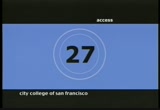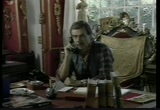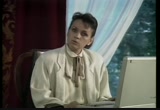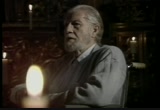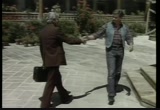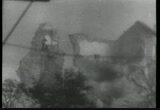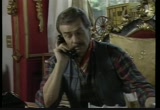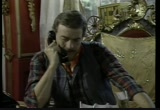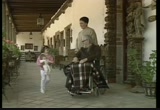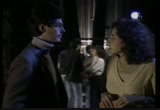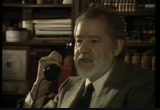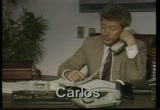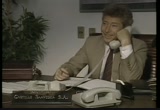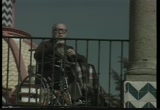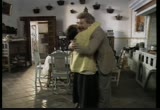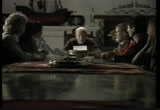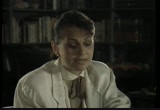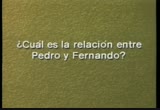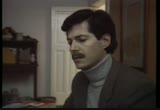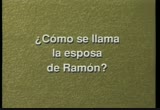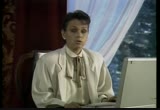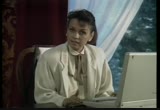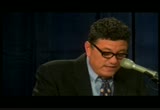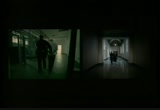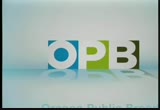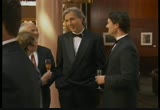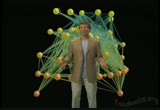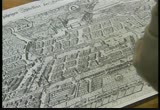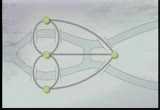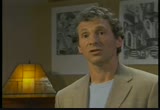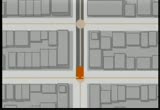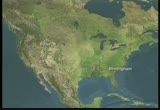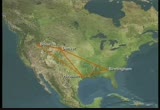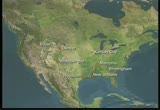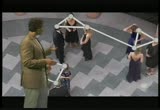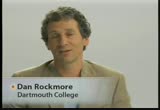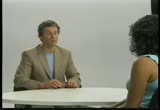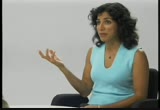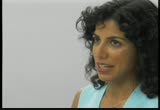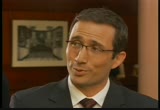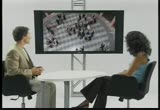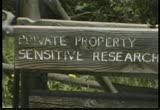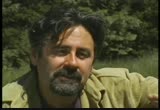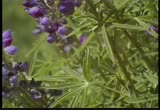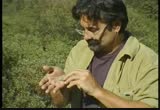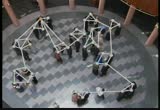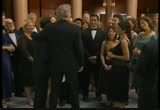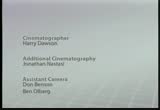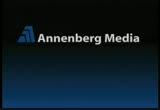tv Democracy Now Special LINKTV November 14, 2012 4:00pm-5:00pm PST
4:00 pm
quote
4:01 pm
and you will learn the secret that don fernando has kept for so long. remember that as you watch an episode of destinos there are three kinds of spanish you will hear: the conversational spanish spoken by the
4:02 pm
narrator: and the spanish spoken by raquel as she reviews major and minor highlights of the episode. fernando tiene cuatro hijos: una hija, mercedes y tres hijos, ramón, carlos y juan. while you will probably understand most or all of the spanish spoken by the narrator and by
4:03 pm
4:04 pm
in the last episode of destinos you met this man, don fernando castillo saavedra. in the twilight years of his life, he has been taken ill. his son ramón has sent for the doctor. julio. ramón. ¿fue largo el viaje? no mucho. ¿y fernando? vamos. está allí arriba. fernando's daughter mercedes waits anxiously for the doctor. hola, mercedes. hola, julio. ¿cómo está tu padre? ¿muy mal? sí. ya lo verás. pasa.
4:05 pm
the doctor knows the news will not be good and later fernando goes into his study and painfully confronts a memory. ( church bells ring ) ramón: papá... ¿papá? ¿estás bien? sí, sí, bien. ¿necesitas algo? sí. llama a tus hermanos. ah, y a tu tío pedro. está bien. ¿algo más? no. nada más. está bien, papá.
4:06 pm
narrador: fernando tiene un secreto un secreto importante. el secreto está en una carta una carta importante. as don fernando requested ramón begins to call his brothers and his uncle. ( teléfono suena ) buenos días, industrias castillo saavedra. ¿me podría comunicar con el señor carlos castillo, por favor? sí. ¿quién le llama? su hermano, ramón.
4:07 pm
iay, ramón! bueno, momentico, por favor. ( teléfono zumba ) sí. ¿señor castillo? su hermano ramón está en la línea. gracias, ofelia. iramón, qué milagro! ¿cómo estás? bien, ¿y tú? bien, con mucho trabajo. ¿qué pasa? te tengo malas noticias. ¿de papá? sí. hoy vino el médico y... ¿puedes venir mañana a la gavia? sí, claro que sí. bien. tengo que llamar a juan. te veré mañana. adiós. bien. te veo mañana.
4:08 pm
( teléfono zumba ) sí, señor castillo. salgo para la ciudad de méxico mañana. sí, bueno. sí, sí, correcto. ( teléfono suena ) hello. hola, juan. habla ramón. iramón, qué milagro! ¿cómo estás? yo bien pero papá está muy mal. ¿qué pasa? hoy vino el médico y... tenemos malas noticias. ¿podrías venir a la gavia? sí, ¿cómo no? hablaré con pati. de acuerdo. nos vemos mañana. sí, sí, está bien. hasta luego. adiós.
4:09 pm
¿dónde está maricarmen? imaricarmen! iabuelito! iabuelito! iabuelito! ven con el abuelito, ¿eh? hola, abuelito. ¿cómo estás? ay, hija, triste, muy triste. pero cántame algo. una canción de animales. ♪ un elefante se columpiaba ♪ ♪ sobre la tela de una araña... ♪ ambos: ♪ dos elefantes se columpiaban ♪ sobre la tela de una araña. ♪ eh, ¿cuándo entra el juez?
4:10 pm
ahora mismo. golpeas. silencio atrás, por favor. puede proseguir la defensa. pati, pero mira quién está allí-- es juan. cinco minutos de descansa, por favor. ( charlan en voces bajas ) ¿qué haces aquí? pati, tengo malas noticias. ¿qué pasa? es papá. está muy mal. sabes, vamos a tener visitas. ¿sí? sí, vienen tus tíos. ¿mis tíos? sí, vienen de los estados unidos. ¿no viene tío carlos? sí, viene con gloria y con tus primos, juanita y carlitos. ¿y también vienen el tío juan y tía pati? ellos también vienen.
4:11 pm
4:13 pm
4:14 pm
4:15 pm
the family members are naturally drawn to the kitchen where lupe, the longtime cook, is setting out a meal. ay, iqué buena! ahorita voy a preparar su desayuno. tengo unas... tengo unos tamales riquísimos. ( risas ) iay, suéltame! isuéltame! isuéltame! iay, niño precioso! está igualita. guadalupe... guadalupe, ¿cómo estás? ¿cómo están? ¿cómo estás, guadalupe? finally, don fernando's brother pedro arrives. with his family gathered around him
4:16 pm
fernando begins to tell them a story he has kept secret all his life. as a young man in spain, he met a beautiful woman named rosario. they fell in love and married at the outbreak of the spanish civil war. the northern town of guernica was bombed. fernando believed that rosario had died in the bombing and like many spaniards he left spain at the end of the civil war as francisco franco set up his military dictatorship. fernando set out for a new life in mexico leaving his past behind and burying the painful memories of the war. he never mentioned rosario to his new family or to his friends. but now, a letter written by a woman from sevilla, spain has forced fernando finally to talk about rosario. in the letter the woman claims that rosario survived the bombing. fernando must find out if this is true for when fernando last saw rosario
4:17 pm
she was carrying their child. fernando: "no sé si me crea "pero es la verdad "y me apena ser yo quien dele esta noticia. "pero creo conveniente que sea así por la amistad "que a rosario me unió. atentamente, teresa suárez". ahora... ya saben ustedes el motivo de esta reunión. es posible que tenga otro hijo. pedro, necesito tu ayuda. sí, sí, claro. naturally, pedro agreed to help his brother in this delicate matter but he was unwilling to leave the family to undertake a long investigation. so, pedro called his affiliate law office in los angeles and asked for raquel rodríguez someone whose investigative talents he had admired
4:18 pm
for some time. raquel agreed to travel to mexico city and to meet pedro castillo in his office. gracias, raquel. esto es muy importante para mí. no hay de qué. bueno, ya me voy. debo repasar la información sobre la familia. bien. adiós. adiós, pedro. bueno, vamos a repasar los miembros de la familia castillo. ¿quién es el padre de la familia castillo? ¿pedro?
4:19 pm
4:20 pm
4:21 pm
carlos vive en miami. ¿y juan? ¿dónde vive? ¿en la ciudad de méxico? ¿o en nueva york? juan vive en nueva york. entonces, la familia castillo saavedra consiste en fernando, el padre y pedro, su hermano. fernando tiene cuatro hijos: una hija, mercedes y tres hijos, ramón, carlos y juan. mercedes y ramón viven en la gavia
4:22 pm
4:23 pm
¿cómo se llama? hola. yo soy carlos castillo. ella es mi esposa. se llama gloria. raquel: ¿rlos y gloria tienen hijos? ellos son mis hijos. ella se llama juanita. el se llama carlitos. esta es mi familia. raquel: juan tiene una esposa. ¿cómo se llama? hola. yo me llamo juan castillo. ella es mi esposa. se llama pati.
4:24 pm
4:25 pm
4:27 pm
4:28 pm
sipc está ahí para protegerlo. sipc. c-i- lo siento, roberto. eso es incorrecto. lisa flores. lisa, tu palabra también es 'sipc'. ¿podría tenerla en otra oración, por favor? los fondos de sipc están disponibles para satisfacer las reclamaciones de los clientes de firmas de corretaje hasta un máximo de $500,000, incluyendo hasta $100,000 por rec 'sipc', eftivo s-i-p-k. ¿no conoce a sipc - securities investor protection corporation? no importa. se lo deletrearemos. visite nos www.sipc.org.
4:29 pm
4:30 pm
4:31 pm
everything we experience -- in nature as well as human activity -- involves a series of connections that link one thing to another. networks, you might say, make the world go round. [ indistinct chattering ] meet raymond price: media tycoon, power broker, and center of attention. this is his party, his network. enter joe smith. he's just crashed the social event of the year and apparently doesn't know a soul. but this is one network joe would like to join. now, if he could only get connected. >> nice party. >> mr. price knows how to entertain. >> you know raymond price? >> no. i'm too low on that totem pole. apparently, even my date thinks so. >> does he know... >> i don't know.
4:32 pm
but i'm sure he knows somebody who knows somebody who -- well, you know what i mean. >> and he left you just hanging here? >> disconnected. >> joe's working the social network for an introduction. but this is just one of the countless networks that pervade our lives. mathematicians define a network very simply: as a collection of entities that somehow relate to each other. many networks are man-made: communication networks, like the internet, telephone, television, and radio; transportation networks, from the airlines to country roads, freeways, highways, and railways; utility networks, elaborate power grids that stretch across entire continents. but most networks are not made by man, because they're literally a fact of nature. river systems and the bundles of neurological connections in our brains: these networks are all physical, describing a relation created by some physical connection, even if it's something like a cell-phone signal. but other networks are more
4:33 pm
abstract, almost virtual: social networks, networks based on relationships of friendship; food webs, networks based on feeding relationships between species; markets and economies linked together by the flow of capital. in some sense, we could argue that everything on the planet, both living and inanimate, is part of one huge, beautiful, but complicated network. what do all these networks have in common? abstractly, they are comprised of intersections, or points, that we call nodes, or vertices, that are connected by lines, or paths, that we call edges. now, on this map, for example, cities are nodes and highways are edges. any real-life network can look very messy. in order to get to the heart of a network, mathematicians strip away all the particulars, leaving only the essence, the underlying mathematical graph. it was just such a process of reducing a map to its basic
4:34 pm
components that laid the foundation for graph theory, network theory, and topology, three of the most bountiful areas of mathematics. and it all began with seven bridges when one of the greatest mathematicians of all time, leonhard euler, turned his attention to the famous puzzle of the konigsberg bridges in prussia in 1732. now, konigsberg is split by the river pregel, and smack in the middle of the river is the island kneiphof, connected by seven bridges to the mainland. and it was a natural problem both for efficiency and just puzzling to decide, was it possible to traverse all seven of the bridges of konigsberg in one trip without crossing any bridge more than once? now, the puzzle had intrigued the residents of konigsberg for many years, and it was a popular pastime to try and find a path or to show that there couldn't be one. and euler, who lived in konigsberg, approached the problem in a very novel way: he realized that the problem was not about geography. it had nothing to do with the lengths of the bridges or their
4:35 pm
distances from one another, but it had everything to do with their connectivity properties: which bridges are connected to which islands or riverbanks. and so for euler, the land masses were nodes, the bridges were edges, and all he had to focus on was how many edges were connected to each node. he described the number of connections as "degree." for example, since this node has three edges connected to it, it's said to have an odd degree. euler noticed that every node, or vertex, of the bridges of konigsberg had an odd degree: three nodes had degree 3 and one node had degree 5. euler realized that every time you travel an edge into a vertex, you have to leave by another edge in order to avoid crossing the previous edge again. that means if you're never going to double back, then the number of edges coming out of each vertex must be twice the number of times you visit that vertex. in other words, every interior vertex of the trip has to have even degree. now, since all the nodes at konigsberg had an odd number of
4:36 pm
edges -- each node with an odd degree -- there was no route that crossed all seven bridges without crossing one more than once. but what happens if we remove one of the konigsberg bridges? this node here has two edges now connected to it, this one has degree 4, and two of these have degree 3. so now we have two of even degree and two of odd degree. now, having done this, in fact, we can find a path that uses each bridge exactly once. and this is a much more general phenomenon. if you have two vertices of odd degree and all the rest even, then you can always find one of these so-called eulerian paths in the network. now, a second way in which you can also have an eulerian path is if all the vertices have even degree. in this case, the path will begin and end at the same vertex, and it's a cycle, or an eulerian cycle. but since all the nodes of the original konigsberg bridges are with odd degree, we can't complete either the eulerian cycle or the eulerian path.
4:37 pm
ler gave us way talk about graphs that can be used to express today's networks mathematically. and we can begin to see how his theories are so important to the highly connected world that we live in today, even with something as basic as a municipality planning its snowplow routes. intersections are nodes on this graph and the streets are the edges, and as the plow finishes one street and hits the intersection, it starts plowing down another street. and when it does, it leaves the intersection, as long as the intersection has even degree. that would mean that there's another edge coming into the intersection and an edge going away from it. remember, if all the nodes have even degree, we have an eulerian cycle. so if the snowplow travels a route in which all the roads are hit only once, its route is more efficient because the snowplow is not retracing streets that have already been cleared. in fact, if we think about networks as being about communication, then the idea of connectivity is crucial to understanding how they work. at the very least, it's critical
4:38 pm
that any one point be reachable from any other point, because they can only interact if two nodes are linked either directly or indirectly. but connectivity is about more than just being connected. it's also a matter of design and measurement, whi thich ares that airlines have to take into consideration when they're planning their routes. for example, it may not be economically wise fooceanic air to run direct flights from birmingham, alabama, to boise, idaho, but they can certainly get you there through connections, like thhubs in houston or denver. and usually, you can come back. an airline network is a directed network, one in which the edges between nodes have an orientation, or direction. st airline networks would actually have two directed edges betweenos, one in each direction. directed networks add an extra level of complexity to the situation, since generally the direction of an edge indicates that you can only travel one way the edge. maybe that's what accounts for the confusions of morn air travel.
4:39 pm
but the most basic kind of network is the undirected network, like that of the bridges of konigsberg, where the direction traveled across each edge is irrelevant. for gument's sake, les assume that our oceanic air company is smart enough to have all connections between cities work in both directions. when we reprent the airline's network by its underlying undirected graph, we see that it's a connected network: any node is reachable from any other. once we know a network is connected, we can ask how tightly it is connected. we measure this in terms of the diameter of the network. say we have airline that not only serves birmingham, houston, denver, and boise, but also albuquerque, kansas city, memphis, and new orleans. let's call these cities our nodes. remember, we can't get directly from birmingham to boise, but we can make some connections to get there. so let's call the flight paths our edges. the fewest number of edges needed to get between two cities
4:40 pm
is called the "distance." so the distance between birmingham and boise is 2. we can now msure the dmeter of the network, which is the greatest distance between any two nodes. it's the greatest number of flights that you must take to get from one place to another. since memphis only connects to birmingham, the diameter of this flight network is 3. a diameter o3 means no more than two transfers. when edges go away, connectivity generally decreases. these statistics get at the large-scale structure of the network, but what about small-scale properties, the sort of "clumpiness" of the network? one way to measure these properties is to show, for any given node, what fraction of nodes in the graph it's connected to. another way is to ask, "what is the probability that it's connected to any other node?" a node connected to a large proportion of the graph is a hub, like an airline hub, which is on average connected directly to more cities than non-hubs. this is a sile notion of clustering, but there are more
4:41 pm
subtle notions inspired by the considerations of social networks. there, instead of asking how likely it is that i'm friends with a random person in the world, we ask how likely is it that two of my friends are themselves friends? in network lingo, we're asking how likely is it that two nodes connected directly to me are themselves connected, that our three little nodes complete a triangle? it turns out that in social networks, the likelihood of these triangles is higher than you would expect, and that those people who find themselves at the hub of many triangles are the ones to know in a social network. let's see if our friend joe can find one of these highly connected and clustered individuals. [ laughing ] >> looks like price is in true form. >> who's that? >> nice party. >> never seen him before. >> you know him? >> yeah, from college. we dated.
4:42 pm
>> hey, he's talking to my date. >> you might say joe is trying to take advantage of what we call "small-world structure," trying to connect with people he doesn't know through other people's relationships. >> hey, i think know her. julie -- julia. >> it looks like joe just found one of those connections. so joe is trying to work the social network here, and it turns out that if you know a little bit of mathematics, it's easier to do it. so we're lucky to have with us today raissa d'souza, who's a professor at uc davis and an expert in network theory. raissa, joe's trying to make his way through the social network. social networks are a little complicated, so is there an easier example that we can start with to explain what it is he's trying to do? >> the simplest network we might think of is highly ordered and regular, so we might even think of like a grid or a piece of graph paper, so a regular lattice where everybody has four links to their nearest neighbors, and they have four links to their nearest neighbors, so the geometry is perfectly ordered and regular.
4:43 pm
and it's much easier to do some mathematics with regular structures like that, so we know the connections, so we would know how to navigate through a network like that and cover all the edges in a really efficient manner. >> so it's one thing to be presented with an ordered network, like the streets of new york, for example, and it's completely believable that we can understand everything about those. but an amazing and beautiful theory is that we can also understand everything about a totally random network. and you could have many different models of what does it mean to have a random network, but one of the more interesting ones is one due to two hungarian mathematicians, paul erdos and alfred renyi. so maybe you could explain to us, what does it mean for a network to be random? >> in contrast to the ordered graph, where everybody has the same number of connections and regular geometry, we might think about those edges being there or not being there with some probability. so we might want to start out in the extreme example where we'll think of everybody being connected to everybody else in
4:44 pm
the network. and we typically call that the complete graph. and how we're going to make it into a random network is we'll go through edge by edge and flip a coin to decide whether that edge stays or goes. and i have a coin with me -- >> math in action. >> so in this case, we're going to let the edges exist with probability 50-50. >> okay. >> why don't you choose an edge? >> all right. i'm going to take the one in the upper corner over there. >> and that's a tails, so we're going to remove that edge. >> so now i'm going to go for something right in the middle, that one. >> and that one's a head, so we're going to keep that. >> one more over in the lower quadrant there. >> and that one's a tail, so we're going to remove that edge. >> we're going to chop that one out. >> and now we'll go through -- >> so we would do that for every single edge in the network and then we'd get some structure, which is random in the sense it was constructed by this random process. if you had 100 mathematicians flipping 100 coins with 100 complete graphs, you could say on average what the properties of one of those graphs would be.
4:45 pm
>> exactly. >> but the way that networks generally come about in the world, of course, is in a more evolutionary way. you start off probably with many disconnected things and then, slowly but surely, they get connected in some fashion. >> yeah, and we can think of a whole equivalent kind of process where we're growing a random graph that will get us to the same point as where we started from the complete graph and pruned edges. so i have an example to tell you about with buttons and thread. what we're going to do is think of each button as a node. and they're all disconnected, so no one has any edges yet. and i'm going to take some thread and start choosing two buttons at random that aren't yet together and sew them together. and now i'll find another two buttons that aren't yet connected and connect them. and i'll keep drawing two buttons at random and connecting them. each time i'm going to find an edge that isn't yet present and add it. >> put it in. >> so i'm just going to draw an edge uniformly at random from all the edges that could be there. >> from all the potential edges. >> all the potential edges.
4:46 pm
and as we start joining buttons together, initially we will have two buttons, and then it might become three buttons or four buttons. and whatever small group of buttons are connected to each other, we call a component. so they're connected to each other but not to other places. so they're small clumps. eventually we'll get to the point where we're starting to merge components. >> so we begin to get something very large and cohesive. >> and what's fascinating of the erdos-renyi random graph is that there's a critical point where i start adding one or two edges and it changes the underlying properties. and suddenly all those smaller components merge together, and i get a giant component. so just one or two edgeshanges the underlying property dramatically. so you might think about some networks where we really want to have connectivity, like in a telecommunications network. and then in the opposite point of view, we might think about epidemiology. >> right, where you want things to be very disconnected so that
4:47 pm
actually the disease can't get across from one community to another. >> exactly. so that phase transition is really -- changes the underlying properties of the graph. and that was one of the most amazing things of the erdos-renyi random graph model. it's so simple, it tells us the ensemble of random graphs, but it has this beautiful property of a phase transition. >> so on the one hand, we understand the totally regular, and we have a lot of understanding of what happens randomly. but the social network, like the one that joe's trying to navigate there to get to the tycoon, is somewhere in between. >> that's right, like most networks in reality. and there are mechanisms that we think are important for how people interact with each other. >> we can turn that into network language, right? that if i'm here and i have a friend here, we're connected by friendship, and i have another friend, i'm also connected to this friend by friendship, then the presumption is, actually, that there's a triangle of friendships, that my friends know each other. >> we're trying to understand potential mechanisms that we
4:48 pm
think drive human behavior and then looking at example networks to see whether our theories are backed up by data from the real networks. >> all right. well, let's see if joe has a good understanding of what a social network looks like. >> great. >> julia, julia wells. i haven't seen you since... >> joe, what brings you here? >> well, honestly, i'm crashing the party to meet mr. price. joe smith. >> hello. >> obviously, you know maggie. everyone, this is maggie. >> hi, nice to meet you. >> maggie says you might know somebody. >> well, i know several people. sounds like you're here to do some networking. >> absolutely. let me show you something. >> looks like joe is on his way, taking advantage of networking opportunities to connect to price. it appears that the connected component he's joined is not yet part of the giant component that surrounds price. but knowing joe, they won't stay disconnected for long. >> i think i might be able to reach rapid phase transition fairly quickly.
4:49 pm
>> clever. how did you figure that out? >> i'm a graduate student -- mathematics, network theory. so, harry, who do you know? >> well, i know a broker whose partner is doing some high-level consulting for price ventures, wanda watson. i believe she's right over there. >> let's make this happen. >> so what joe is taking advantage of is this extra structure that is in a social network. in fact, he's really taking advantage of something that we call the small-world structure of the social network. >> and what characterizes something as a small world is that the distance between any two individuals is relatively small. and there's also many more triangles than we would expect in the random graph. >> because of that "friends of friends" kind of thing. >> exactly. >> so joe's really taking advantage of some mathematical ideas here, is that right? >> he's learning how to navigate through that small world. >> all right, terrific. well, thanks so much for helping
4:50 pm
us figure this out. >> oh, my pleasure. >> so social networks are just one kind of evolved network. and another kind are food webs, networks that exist between animals. and we're going to visit now with neo martinez, a scientist at the pacific ecoinformatics and computational ecology lab in colorado. >> i'm neo martinez, i'm the director of the pacific ecoinformatics and computational ecology lab. math is very important to our studies. we represent ecosystems as networks by designating which species live in a habitat and who eats whom among those species. so the network has species as the nodes and feeding relationships as the links between the nodes. network theory is an increasingly used body of theory to understand systems. many scientists are realizing that it's a wonderful framework to basically connect the dots
4:51 pm
within their systems. the advantage we gain by viewing an ecosystem as a network is the ability to track effects from one species to other species within the network. one of the main other bodies of theory that we use is the theory of non-linear dynami, also known as chaos theory, and we use that theory to structure equations that calculate the energy flow through our ecosystem from plants, say, to herbivores to carnivores. it's important to understand the effects of species on one another because that is changing quite a bit these days. many species are going extinct due to human activity, and also new species are invading ecosystems due to human activity. ecosystems form much more tightly connected networks than many other networks. what happens is that each
4:52 pm
species is typically within three links of all other species within the ecosystem. that's a lot closer than, say, the six degrees of separation that is supposed to separate human's familiarity networks, "who knows who" within, say, the u.s. and so these are tight networks where effects on one species can propagate to many other species quite quickly. one of the most famous examples of the effects of one species on the others within the ecosystem through the network that we've been studying is the sea otter example. back in the 1800s, the russians and several other western countries paid native americans to hunt sea otters pretty much to the extinction of them in many habitats across the pacific coast. when the otters went extinct, the sea urchins, what the otters
4:53 pm
ate, started getting really, really abundant. those urchins ended up eating a lot more kelp than usual. and they pretty much destroyed the kelp forests. the whole ecosystem that depended on the kelp was wiped out. so one of the neat sort of network-y things about this system is that if you look at this plant, this lupin, you'll find some ants walking all over it, they sort of patrol it. what happens is many plants in this habitat have nectaries, little places that provide food for the ants. in return, the ants walk all over the plant and wipe out the aphids, little plant-sucking insects that would normally eat a lot more plant than the plant gives to the ants. and so by givinghe ants a little bit of food, they save themselves quite a bit of damage
4:54 pm
by the aphids. our studies of ecological networks are important to people because people want to know if they can depend on their food to be there and if they can depend on their predators not being there. i think one of the most fun parts of this research for me is the fact that it really gives us the opportunity to figure out how the whole system operates. a lot of science is what we call reductionist science, looking at the little parts. network studies allow us to put those parts together and understand how the whole system operates. the combination between the intellectual intrigue of putting all these pieces together and being able to visit beautiful places like this makes my job rock. >> animals eating one another is one thing, but people making friends is another. and remember that social networks are generally small-world networks, ones with
4:55 pm
lots of triangles and small diameter. which brings us back to joe and the party, where some classic small-world dynamics are taking place. most people here have only a few connections, but a few people have high connectivity. because of this, it seems any given person is only a few handshakes away from anyone else by way of introduction. >> hi, i'm joe smith. >> hi, wanda watson. >> nice to meet you, wanda. i believe you know harry. >> oh, yes, harry. it's good to see you again. >> harry and i met through maggie. >> i hear that wanda would like to introduce someone to me. is that him? >> who? >> the guy with wanda watson. >> i'll go get them. >> what we're seeing here now is the emergence of a giant component. that is, a connected subset of the graph that includes a very large fraction of the vertices. this rapid phase transition would have occurred even if our guests had been making friends randomly.
4:56 pm
but with joe's focus on making friendships to reach raymond price, we see it come about even more quickly. >> wanda, you're looking lovely. >> thank you, raymond. allow me to introduce a very impressive young man i've just met. raymond price, joe smith. >> welcome to my party, joe. it seems we know a lot of the same people. >> thank you, sir. i can't tell you what an honor it is to make this connection. >> seems like i've known him almost an hour now. [ laughter ] >> networks. we're all surrounded by and part of a vast array of them. they bind us together, connecting information, people, animals, even snowplows. mathematics helps us understand how those networks grow, how they operate, and how they affect us. indeedno man, no person, no animal, no object -- organic or inorganic -- is an island.
4:58 pm
404 Views
IN COLLECTIONS
LinkTV Television Archive
Television Archive  Television Archive News Search Service
Television Archive News Search Service 
Uploaded by TV Archive on

 Live Music Archive
Live Music Archive Librivox Free Audio
Librivox Free Audio Metropolitan Museum
Metropolitan Museum Cleveland Museum of Art
Cleveland Museum of Art Internet Arcade
Internet Arcade Console Living Room
Console Living Room Books to Borrow
Books to Borrow Open Library
Open Library TV News
TV News Understanding 9/11
Understanding 9/11